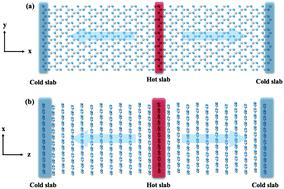当前位置:
X-MOL 学术
›
Phys. Chem. Chem. Phys.
›
论文详情
Our official English website, www.x-mol.net, welcomes your
feedback! (Note: you will need to create a separate account there.)
Thermal transport properties of graphite carbon nitride
Physical Chemistry Chemical Physics ( IF 2.9 ) Pub Date : 2020-10-06 , DOI: 10.1039/d0cp03513k Jieren Song 1, 2, 3, 4 , Zhonghai Xu 1, 2, 3, 4 , Lizhi Tang 4, 5, 6 , Linlin Miao 1, 2, 3, 4 , Chaocan Cai 1, 2, 3, 4 , Yujiao Bai 1, 2, 3, 4 , Rongguo Wang 1, 2, 3, 4 , Xiaodong He 1, 2, 3, 4, 7
Physical Chemistry Chemical Physics ( IF 2.9 ) Pub Date : 2020-10-06 , DOI: 10.1039/d0cp03513k Jieren Song 1, 2, 3, 4 , Zhonghai Xu 1, 2, 3, 4 , Lizhi Tang 4, 5, 6 , Linlin Miao 1, 2, 3, 4 , Chaocan Cai 1, 2, 3, 4 , Yujiao Bai 1, 2, 3, 4 , Rongguo Wang 1, 2, 3, 4 , Xiaodong He 1, 2, 3, 4, 7
Affiliation

|
Graphite carbon nitride (GCN), which can be regarded as a nitrogen heteroatom-substituted graphite framework, has attracted great attention as a new 2D layered structure material with semiconductor electronic characteristics. Using molecular dynamics simulations, the in-plane thermal conductivity and cross-plane thermal resistance of two GCN structures (i.e., triazine-based and heptazine-based) are investigated. Our results show that the in-plane thermal conductivities of the triazine-based and heptazine-based GCN monolayers along the armchair direction are 55.39 and 17.81 W m−1 K−1, respectively. The cross-plane thermal resistance decreases with increasing layer number and reaches asymptotic values of 3.6 × 10−10 and 9.3 × 10−10 m2 K W−1 at 40 layers for triazine-based and heptazine-based GCN, respectively. The in-plane thermal conductivity can be effectively manipulated by changing the temperature and applying strain, while it is insensitive to the number of layers, which is in sharp contrast to that of graphene. Moreover, the cross-plane thermal resistance decreases monotonically with temperature and coupling strength, and can be modulated by external strain. Surprisingly, the cross-plane tensile strain can reduce the thermal resistance of the heptazine-based GCN. Our study serves as a guide to groups interested in the physical properties of GCN.
中文翻译:

石墨氮化碳的热传递性质
可以被视为氮杂原子取代的石墨骨架的石墨碳氮化物(GCN)作为具有半导体电子特性的新型2D层状结构材料已引起了极大的关注。使用分子动力学模拟,研究了两个GCN结构(即三嗪基和庚嗪基)的面内热导率和跨面热阻。我们的结果表明,沿扶手椅方向的三嗪基和庚嗪基GCN单层的平面内热导率分别为55.39和17.81 W m -1 K -1。横断面热阻随着层数的增加而减小,并达到3.6×10 -10和9.3×10的渐近值40层分别为基于三嗪的和基于庚嗪的GCN的-10 m 2 KW -1。通过改变温度和施加应变,可以有效地控制面内热导率,同时它对层数不敏感,这与石墨烯的层数形成鲜明对比。而且,横截面热阻随温度和耦合强度而单调降低,并且可以通过外部应变进行调节。出乎意料的是,横断面拉伸应变可以降低基于庚嗪的GCN的耐热性。我们的研究为对GCN物理性质感兴趣的人群提供了指南。
更新日期:2020-10-16
中文翻译:

石墨氮化碳的热传递性质
可以被视为氮杂原子取代的石墨骨架的石墨碳氮化物(GCN)作为具有半导体电子特性的新型2D层状结构材料已引起了极大的关注。使用分子动力学模拟,研究了两个GCN结构(即三嗪基和庚嗪基)的面内热导率和跨面热阻。我们的结果表明,沿扶手椅方向的三嗪基和庚嗪基GCN单层的平面内热导率分别为55.39和17.81 W m -1 K -1。横断面热阻随着层数的增加而减小,并达到3.6×10 -10和9.3×10的渐近值40层分别为基于三嗪的和基于庚嗪的GCN的-10 m 2 KW -1。通过改变温度和施加应变,可以有效地控制面内热导率,同时它对层数不敏感,这与石墨烯的层数形成鲜明对比。而且,横截面热阻随温度和耦合强度而单调降低,并且可以通过外部应变进行调节。出乎意料的是,横断面拉伸应变可以降低基于庚嗪的GCN的耐热性。我们的研究为对GCN物理性质感兴趣的人群提供了指南。











































 京公网安备 11010802027423号
京公网安备 11010802027423号